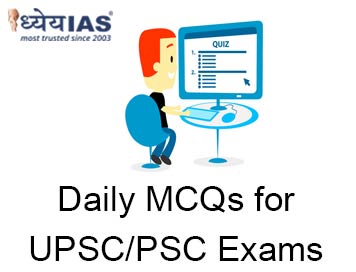Home > Daily-mcqs
Daily-mcqs 08 May 2025

Q1:
Which of the following actions may be justified under Article 51 of the UN Charter? How many of the above actions are potentially justified under Article 51?
A: Only one
B: Only two
C: Only three
D: All four
Answer: C
Explanation:
Actions 1, 2, and 4 can be justified under Article 51:
U.N. Charter’s Article 51 states “Nothing in the present Charter shall impair the inherent right of individual or collective self-defence if an armed attack occurs against a Member of the United Nations, until the Security Council has taken measures necessary to maintain international peace and security.
Q2:
Which of the following initiatives are aligned with India’s commitment to the UN Decade of Action for Road Safety (2021–2030)? How many of the above are aligned?
A: Only one
B: Only Two
C: Only Three
D: All four
Answer: D
Explanation:
All listed initiatives support India’s goal to reduce road fatalities by 50% by 2030, in line with the UN Decade of Action.
Q3:
Consider the following statements regarding Operation Sindoor: Statement 1: Operation Sindoor is an example of India’s traditional defensive posture in cross-border military strategy. Which of the following is correct?
Statement 2: India aims to impose strategic and reputational costs on terror sponsors through precision strikes.
A: Both statements are correct, and Statement 2 explains Statement 1
B: Both statements are correct, but Statement 2 does not explain Statement 1
C: Statement 1 is incorrect, but Statement 2 is correct
D: Both statements are incorrect
Answer: C
Explanation:
Operation Sindoor represents a shift from India’s defensive posture to a more assertive, preemptive, and deterrence-based military strategy, especially after the Uri (2016) and Balakot (2019) strikes. It involved coordinated strikes across multiple terror-linked sites, marking a doctrinal change that emphasizes proactive disruption of cross-border threats. Hence, Statement 1 is incorrect.
Statement 2 is correct—India’s operations are designed to impose both strategic and reputational costs on state and non-state sponsors of terrorism, signaling that proxy warfare will be met with calibrated, high-impact responses.
Q4:
Consider the following statements: Statement 1: The India–UK FTA includes social security exemptions for Indian workers in the UK. Which one of the following is correct?
Statement 2: This exemption applies for up to three years and is part of a double contribution convention.
A: Both statements are correct, and Statement 2 explains Statement 1
B: Both statements are correct, but Statement 2 does not explain Statement 1
C: Statement 1 is correct, but Statement 2 is incorrect
D: Both statements are incorrect
Answer: A
Explanation:
The FTA includes a landmark provision under a Double Contribution Convention, exempting Indian workers posted in the UK from paying into UK social security for up to three years. This reduces the financial burden for Indian employees and employers abroad, thereby encouraging short-term labour mobility without dual social security deductions.
Q5:
Which of the following tributaries of the Chenab joins it between Kishtwar and Akhnoor?
A: Bhut Nallah
B: Liddrari
C: Neeru
D: Thirot
Answer: C
Explanation:
The Neeru River is one of the key tributaries that joins the Chenab between Kishtwar and Akhnoor. Others in this stretch include Kalnai, Raghi, Bichleri, and Ans. Thirot, Bhut Nallah, and Liddrari join the Chenab before Kishtwar, in its early Himalayan course.